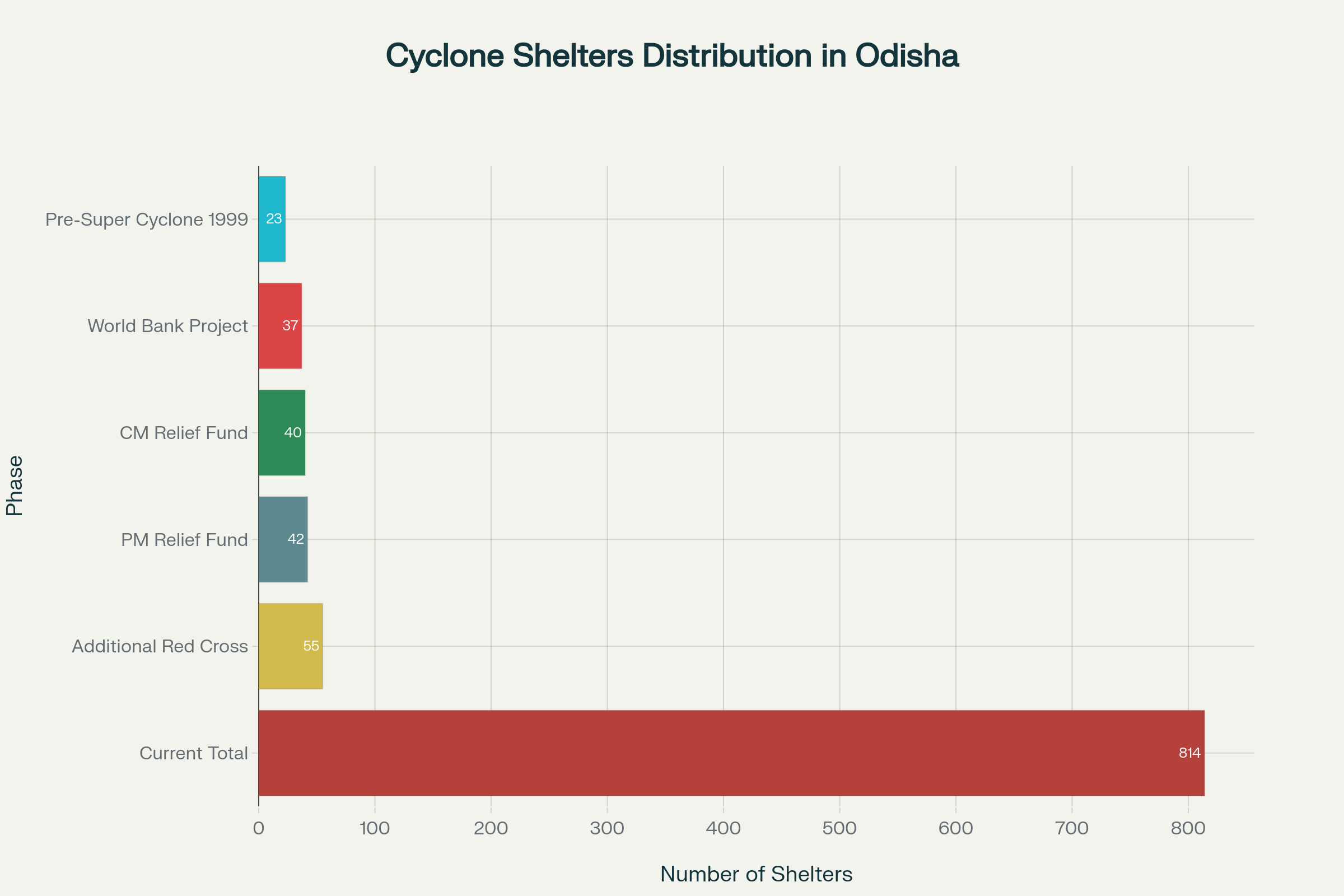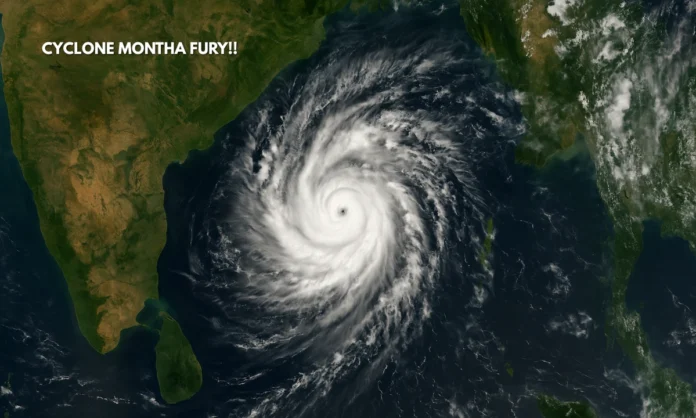The state of Odisha has activated its comprehensive disaster management framework as meteorological authorities track a developing Cyclone Odisha October 2025 system in the Bay of Bengal, expected to bring heavy rainfall and strong winds from October 27-29, 2025. The India Meteorological Department (IMD) has issued alerts across all 30 districts of the state, with coastal and southern regions facing the highest risk of severe weather impacts.
Key Highlights:
- Low-pressure area formed over southeast Bay of Bengal on October 24, expected to intensify into Cyclone Montha by October 27
- Odisha’s 814 multi-purpose cyclone shelters across 25 districts are ready for evacuation operations
- Wind speeds may reach 50-60 kmph gusting to 70 kmph along the coast from October 28-29
Cyclone Odisha October 2025: Meteorological Development and Forecast
The IMD has been tracking the weather system since October 24, when a low-pressure area formed over the southeast Bay of Bengal. Director of IMD Bhubaneswar, Manorama Mohanty, confirmed that this Cyclone Odisha October 2025 system is likely to intensify into a depression by October 25, followed by a deep depression on October 26, and ultimately develop into a cyclonic storm over the west-central and southwest Bay of Bengal by October 27. The storm, which will be named “Montha” (meaning “fragrant flower” in Thai), is expected to track toward the Andhra Pradesh coast while significantly impacting the Cyclone Odisha October 2025 weather patterns.
The meteorological progression follows a predictable intensification pattern, with squally weather conditions anticipated along the south Odisha coast starting October 27. Wind speeds are forecast to reach 40-50 kmph with gusts up to 60 kmph initially, escalating to 50-60 kmph gusting to 70 kmph from October 28-29. Heavy to very heavy rainfall is expected across coastal and southern districts, with the IMD issuing orange warnings for multiple districts including Ganjam, Gajapati, and Rayagada.
Severe #CycloneMontha Update 3 🌀
— Athreya Shetty 🇮🇳 (@shetty_athreya) October 25, 2025
Depression 94B moved westwards over last 24 hrs, and lay about 490km west of Sri Vijaya Puram as of 12pm on 25th October.
To intensify into a Deep Depression by tonight and further into a Cyclonic Storm by Monday 27th while moving WNW towards… https://t.co/Vscr8z5ZHj pic.twitter.com/FO46b1kykm
Cyclone Odisha October 2025: State Government Preparedness Measures
Revenue and Disaster Management Minister Suresh Pujari has assured that the Cyclone Odisha October 2025 response maintains full preparedness for the approaching cyclonic storm, emphasizing the state’s experience in handling natural disasters. The minister confirmed that all key departments, including Health, Water Resources, Energy, and Agriculture, have coordinated their response mechanisms and are ready to tackle the situation. Local administrations across vulnerable areas have established relief centers, evacuation protocols, and arranged for essential supply distribution.
The state’s disaster management approach reflects lessons learned from the devastating 1999 Super Cyclone, which marked a paradigm shift toward proactive preparedness rather than reactive response. Odisha has invested significantly in building disaster-resilient infrastructure, with over 814 multi-purpose cyclone shelters constructed across 25 cyclone and flood-prone districts. These shelters are designed to withstand wind speeds of up to 300 kmph and feature elevated construction above recorded high tide levels to prevent storm surge inundation.
Cyclone Odisha October 2025: Infrastructure and Evacuation Capabilities
Odisha’s cyclone shelter network represents one of the most comprehensive disaster preparedness infrastructures in the world, developed through multiple phases following the 1999 Super Cyclone. The current inventory includes 814 shelters built by the Odisha State Disaster Management Authority (OSDMA) and an additional 65 constructed by the Indian Red Cross Society. Each shelter building features stilted construction with separate facilities for men and women, ramps for physically challenged access, and approximately 32 types of emergency equipment including noise-less generators, inflatable tower lights, and search and rescue equipment.

The shelter construction program evolved through distinct phases, beginning with 23 Red Cross shelters prior to 1999, followed by systematic expansion under various funding mechanisms. The World Bank-supported National Cyclone Risk Mitigation Project contributed significantly to this infrastructure development, with shelters strategically located within 10 kilometers of the coastline in six coastal districts. This comprehensive network has demonstrated its effectiveness during recent cyclones, with the state successfully evacuating 1.55 million people to 9,177 shelters during major weather events.
Early Warning Systems and Community Preparedness
The IMD’s cyclone forecasting accuracy has improved dramatically over the past decade, with the department claiming to be the world’s best in Cyclone Odisha October 2025 prediction accuracy. Current forecasting capabilities provide accurate landfall predictions 4.5 days in advance, compared to international agencies that typically issue forecasts 1.5 days ahead. This enhanced lead time enables comprehensive evacuation and preparedness measures, significantly reducing potential casualties and property damage.
Community-based preparedness forms a crucial component of Odisha’s disaster management strategy, with over 100,000 trained volunteers and grassroots organizations participating in regular mock drills conducted every June and November. The state has departed from conventional top-down disaster management approaches by empowering local communities, gram panchayats, and women’s self-help groups to lead disaster risk reduction and relief operations. This community-centric model has proven highly effective, with various government departments, district collectors, NGOs, and trained volunteers participating in coordinated response exercises.
Economic and Agricultural Impact Assessments
The approaching Cyclone Odisha October 2025 system poses significant risks to the state’s agricultural sector, particularly with the timing coinciding with post-harvest activities and winter crop preparations. Minister Pujari acknowledged the potential impact on farmlands and crop losses, confirming that the government maintains close coordination with agricultural departments to assess and mitigate damage. The Energy Department has prepared for potential power outages, a common consequence of cyclonic storms, with contingency plans for rapid restoration of electricity supply.
Odisha’s economy, heavily dependent on agriculture and coastal industries, faces recurring challenges from cyclonic disturbances during the October-November period, traditionally considered the peak cyclone season. The state’s proactive approach to disaster management has significantly reduced economic losses compared to historical patterns, with improved forecasting and preparedness measures enabling better protection of critical infrastructure and productive assets. The comprehensive shelter network and evacuation procedures have proven instrumental in maintaining economic continuity by ensuring workforce safety and enabling rapid recovery operations following severe weather events.
Closing Assessment
Odisha’s response to the developing Cyclone Odisha October 2025 system demonstrates the state’s evolution into a global model for disaster preparedness and management. The comprehensive infrastructure network of 814 cyclone shelters, combined with advanced meteorological forecasting and community-based preparedness programs, positions the state to effectively manage the approaching weather system. With all government departments coordinated and evacuation protocols activated, the Cyclone Odisha October 2025 disaster management framework reflects nearly two decades of systematic improvement following the 1999 Super Cyclone.
The state’s proactive stance, emphasizing preparation over reaction, has transformed Odisha from one of India’s most vulnerable regions into a resilient disaster-ready state. As Cyclone Montha approaches, the effectiveness of this comprehensive preparedness model will once again be tested, with the potential to further validate Odisha’s leadership in disaster risk reduction and community resilience during this critical Cyclone Odisha October 2025 period.


